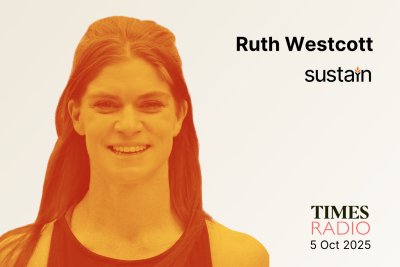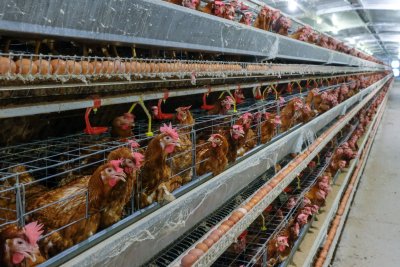Sustain reveals industry’s widespread failure to disclose emissions.
Livestock megafarm operators are routinely failing to disclose their impact on climate change, new research from Sustain and DeSmog can reveal.
Sustain reviewed recent planning applications for large intensive pig and poultry facilities across major farming regions of the UK. The findings indicate persistent, systemic non-compliance with rules that require the disclosure of environmental information, leaving planning decisions vulnerable to legal challenge.
None of the applications analysed included the required greenhouse gas (GHG) emissions assessment. If approved, at least an estimated 128,000 additional pigs and 37 million chickens would be raised in megafarms each year, while the environmental damage remains hidden from the public and decision makers.
Why this matters
Intensive livestock farming generates significant greenhouse gas emissions. If all the applications in our assessment were approved, they could generate an estimated 634,000 tonnes of CO₂-e annually; the equivalent of 370,000 return flights from London to New York.
A typical poultry development of 3-4 sheds (each holding around 40,000 birds) could emit in the region of 12,000 - 16,000 tonnes of CO₂ equivalent (tCO₂e) per year. This is more than four times the carbon footprint of West Lindsey District Council in Lincolnshire, and equivallent to the transport emissions of a town of about 8,000 people. In other words, a single poultry development of this size could cancel out a local council's entire carbon mitigation plan and emit as much GHGs as the transport activity of a nearby market town. Producing the same amount of edible protein or calories from pulses, lentils or peas would reduce the greenhouse gas footprint by 70-90%.
Emissions arise largely from the production of feed which is often linked to deforestation, as well as from on-site energy use, heating, and ventilation. Additional emissions result from manure storage and spreading, including its transport and treatment, and from the movement of animals to slaughter and processing facilities.
These emissions are both foreseeable and quantifiable using standard UK Government and IPCC methodologies and must therefore be assessed as part of an Environmental Statement (ES) and submitted with a planning application. Failing to provide such a assessment leaves communities unable to assess the risks posed to our planet’s health as well as local and national targets to reduce harmful emissions and recover nature. Planning decisions made in absence of the required environmental information are vulnerable to being overturned by judicial review.
In the UK’s Seventh Carbon Budget, released in February 2025, the Climate Change Committee set out explicit targets to reduce livestock numbers and reduce consumption of all meat by 25% by 2040 to stay within emissions levels that would prevent the worst impacts of climate change. The latest international EAT-Lancet commission report calculated that globally, nearly one third of premature deaths could be avoided through moderate switches to a diet lower in meat, and high in vegetables, pulses and legumes.
Lily O'Mara, Climate Campaigner at Sustain and 2025 Bertha Challenge Fellow, said:
“It’s no wonder so many farmers are putting up intensive chicken and pig sheds. They’re being squeezed by powerful food corporations, hit by climate change, and given next to no government support to grow healthy, sustainable food.
The government must stop this industry from getting away with devastating pollution. We need full environmental assessments for every facility, no new factories in already polluted areas, and proper enforcement when rules are broken. Local councils have the power to act now by rejecting new industrial livestock units that can’t prove they won’t damage our environment and our health.
Farmers deserve better. Government should be backing them to grow more vegetables, pulses and legumes, restore nature, and raise animals in truly sustainable mixed systems.”
Undeclared emissions from intensive farms
Number of intensive pig and poultry farms in UK declaring emissions in planning applications
Source: Research by Sustain with support from the Bertha Foundation; Analysis by DeSmog
Covers biggest livestock farming regions: Lincolnshire, Norfolk, Suffolk, Nottinghamshire, Shropshire, Yorkshire, Wales and Northern Ireland.
Methodology
Sustain assessed applications in In East Anglia, Lincolnshire, Nottinghamshire, Shropshire, Yorkshire, Wales and Northern Ireland, that have been submitted or under consideration since June 2024. All of these developments required a full Environmental Impact Assessment (EIA) as per the Town and Country Planning (Environmental Impact Assessment) Regulations 2017.
In June 2024, the UK Supreme Court’s judgment in Finch v Surrey County Council (June 2024) confirmed that planning authorities must assess all foreseeable and quantifiable greenhouse gas emissions arising from a development, including direct and indirect (Scope 3-type) emissions such as feed production, transport, and manure disposal.
Ruth Westcott, Campaign manager at Sustain, said:
“Vital information is being kept from councils and the public. We are entitled to know the harm these units cause, and this information could affect planning decisions. It's clear that agribusinesses don't want to come clean about the pollution they cause because it could affect whether they are allowed to expand, and thus make more profits at the expense of our communities.”
TAKE ACTION
Use our planning objection resources to object to live applications that are withholding proper climate impact assessments.
Notes on methodology
All planning applications for livestock farms that met the following criteria were included in our analysis:
-
Situated in East Anglia, Lincolnshire, Nottinghamshire, Shropshire, Yorkshire, Wales and Northern Ireland - the farming regions in the UK that currently have the largest number of intensive livestock units
-
Applications that were under review (i.e. under ongoing consideration or submitted) since the June 2024 Finch ruling
-
Met the threshold size (see below), and thus submitted an Environmental Impact Assessment, and/or an EIA was requested by the Local Planning Authority
Applications were found through key word search of the planning portals for all planning authorities in countries/countries listed above. Environmental Impact Assessments (often called environmental statements) were then reviewed for information on climate impacts.
All developments meeting the definitions in Schedule 1 are required to conduct Environmental Impact Assessments (EIA). This includes “Installations for the intensive rearing of poultry or pigs with more than— (a) 85,000 places for broilers or 60,000 places for hens; (b) 3,000 places for production pigs (over 30 kg); or (c) 900 places for sows.” Some developments defined under Schedule 2 are also rquired to produce EIAs, if they are in sensitive areas or meet certain thresholds. For farms, this is defined as: “The area of new floorspace exceeds 500 square metres”, indicated by “Installations designed to house more than 750 sows, 2,000 fattening pigs, 60,000 broilers or 50,000 layers, turkeys or other poultry.” The law was introduced in the EU in 2014 and transposed into UK law in 2017. Local planning authorities can require an EIA for applications for intensive livestock units below this size, where they deem the likely impacts to be significant.
Calculations for the GHG emissions from intensive chickens and pigs:
Chickens: Each broiler chicken was assumed to produce about 1.5kg edible meat, and each kg cause 9.8kg CO2e
Pigs: Each pig was assumed to produce about 55kg edible meat = (62% yield from 88kg carcasse), and each kg pig meat to emit 12.31kg CO2e.
A return flight from London to New York was calculated to emit 1.3 tonnes CO2e
Lily O'Mara is a 2025 Bertha Challenge fellow and this research was produced as part of the Bertha Challenge Fellowship. Bertha Foundation runs programs that support activists, storytellers and lawyers who are working to bring about social and economic justice, and human rights for all.
UK megafarm operators hiding climate impacts from the public. Credit: Sustain
Food for the Planet: Helping local authorities to tackle the climate and nature emergency through food.








